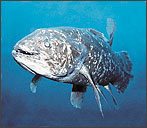
![]()
![]()
![]()
![]()
![]()
COELACANTH
You might expect that when a marine biologist makes the discovery of a lifetime, it would take place in water. But Mark Erdmann, a Berkeley postdoctoral fellow, happened upon his amazing find in -- of all places -- a bustling Indonesian fish market in Manado, a city in northern Sulawesi.
In 1997, Erdmann and his new wife, Arnaz Mehta, fresh from a honeymoon cruise, were stepping out of a taxi at the market when Mehta's attention immediately was drawn to a large, dead fish being hawked by an elderly man.
She was puzzled by the strange, unsavory-looking brown fish with four fleshy paired fins resembling primitive legs. But Erdmann, a biologist, recognized it immediately as a coelacanth (pronounced "SEE-la-kanth").
This rare species of fish is so ancient it dates from before the age of the dinosaurs. The coelacanth was believed to have gone extinct 65 million years ago until a small population was discovered in the Comoro Islands off Africa in 1938. The fish had never before been identified in Indonesia.
"I felt that our discovery was a bit too fortuitous to be real," said Erdmann. "I simply couldn't believe we were viewing something unknown to science," especially "at a bustling market in a relatively large city."
Since a dead fish is not the most romantic companion for honeymooners, Erdmann photographed the 50-pound creature but decided against buying it -- much to his later regret.
The story ends happily, however.
Last July, Erdmann, who lives in Manado and studies the health of Indonesia's coral reefs, observed a second specimen caught by fishermen in the waters off Manado Tua, a nearby island. He photographed the four-foot-long, 64-pound fish as it was swimming, and then preserved the specimen for further scientific examination.
The discovery made a big splash around the world when announced in the journal Nature last September.
Erdmann was able to take tissue samples from the coelacanth and, with University of Texas colleague David Hillis, compared its DNA to that of the Comoran species. The genetic analysis indicates it is a new species that diverged from the Comoran fish more than a million years ago.
More specimens are needed before Erdmann, Hillis and Berkeley colleague Roy Caldwell, chair of integrative biology, can say definitively that this fish is a new species. A year later, however, no new coelacanth has been caught.
![]()
![]()

![]()
[Table
of Contents]
[Berkeley
Magazine Home]
[UC
Berkeley Home Page]
Copyright 2000,
Regents of the University of California. All rights
reserved.
Comments? E-mail ucbwww@pa.urel.berkeley.edu.
